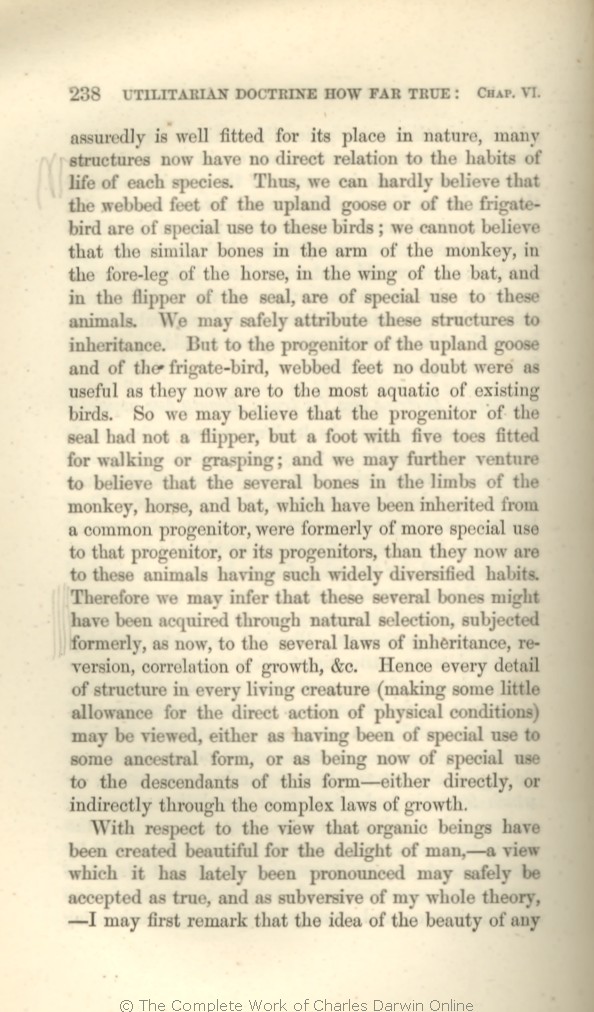assuredly is well fitted for its place in nature, many structures now have no direct relation to the habits of life of each species. Thus, we can hardly believe that the webbed feet of the upland goose or of the frigate-bird are of special use to these birds; we cannot believe that the
similar | similar 1861 1866 1869 1872 | | same 1859 1860 |
| fore-leg 1860 1861 1866 1869 1872 |
| fore leg of 1859 |
| of the 1860 1861 1866 1869 1872 | | the 1859 |
| to 1859 1860 1861 1866 1869 |
| webbed feet no doubt were as useful to 1872 |
| webbed feet no doubt were as useful 1859 1860 1861 1866 1869 |
| OMIT 1872 |
| existing 1859 1860 1861 1866 | | living 1869 1872 |
| had 1859 1860 1861 1866 | | did 1869 1872 |
| a 1859 1860 1861 1866 | | possess a 1869 1872 |
| which have been inherited from a common progenitor, were formerly 1859 1860 1861 1866 |
| which have been in- herited from some ancient progenitor, were formerly 1869 |
| were originally developed, on the principle of utility, probably through the reduction 1872 |
| special use to that progenitor, or its progenitors, than they now are to these animals having such widely diversified habits. 1859 1860 1861 1866 |
| special use than they now are to these animals with their widely diversified habits, and might consequently have been modified through natural selection. 1869 |
| numerous bones in the fin of some ancient fish-like progenitor of the whole class. 1872 |
| 1 blocks not present in 1859 1860 1861 1866 1869; present in 1872 | | It is scarcely possible to decide how much allowance ought to be made for such causes of change, as the definite action of external conditions, so-called spontaneous variations, and the complex laws of growth; but with these important exceptions, we may conclude that the structure of every living creature either now is, or was formerly, of some direct or indirect use to its possessor.
|
| Therefore 1859 1860 1861 1866 |
| Making due allowance for the definite action of changed conditions, correlation, reversion, &c., 1869 |
| infer 1859 1860 1861 1866 | | conclude 1869 |
| these several bones might have been acquired through natural selection, subjected formerly, as now, to the several 1859 1860 1861 1866 |
| every detail of structure in every living creature is either now or was formerly of use,—directly or indirectly through the complex 1869 |
| inheritance, reversion, correlation of growth, &C. Hence every detail of structure in every living creature (making some little allowance for the direct action of physical conditions) may be viewed, either as having been of special use to some ancestral form, or as being now of special use to the descendants of this form—either directly, or indirectly through the complex laws of growth. 1866 |
| inheritance, reversion, correlation of growth, &c. Hence every detail of structure in every living creature (making some little allowance for the direct action of physical conditions) may be viewed, either as having been of special use to some ancestral form, or as being now of special use to the descendants of this form— either directly, or indirectly through the complex laws of growth. 1859 1860 |
| inheritance, reversion, correlation of growth, &C. Hence every detail of structure in every living creature (making some little allowance for the direct action of physical conditions) may be viewed, either as having been of special use to some ancestral form, or as being now of special use to the descendants of this form— either directly, or indirectly through the complex laws of growth. 1861 |
| growth. 1869 |
|









